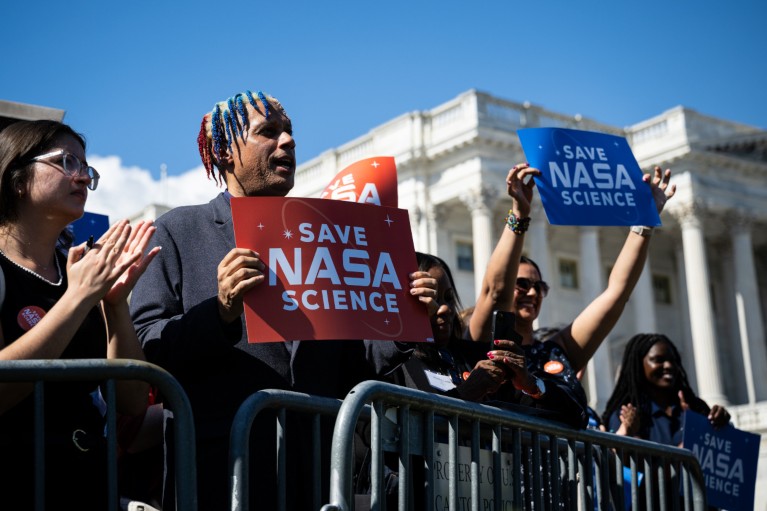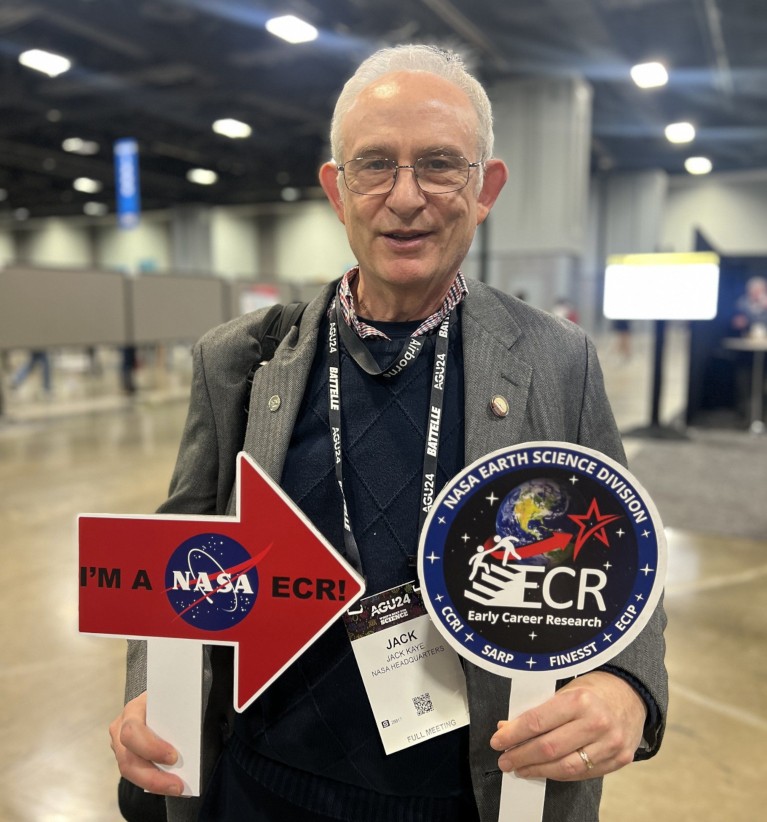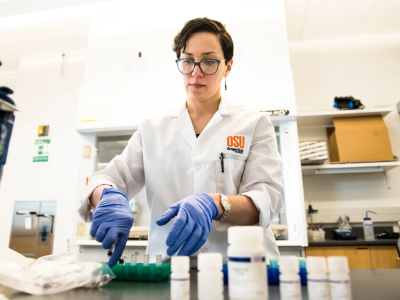
At the US Environmental Protection Agency, scientists say proposed cuts will gut research. Credit: Eric Lee/Bloomberg via Getty
For 30 years, the US Environmental Protection Agency (EPA) has conducted controlled air-pollution studies at a state-of-the-art facility at the University of North Carolina at Chapel Hill. The facility is equipped to test numerous airborne pollutants, including ozone, diesel, wildfire smoke and chlorine. Data collected in its chambers have been pivotal to establishing stricter air-quality standards for deadly pollutants, and have been instrumental in protecting the health of people in the United States.
However, in February, shortly after US President Donald Trump took office, the EPA — which is charged with protecting the nation’s environment and its people’s health — notified the university that it would not be renewing its lease. By May, research had ceased. “There are no other places with the capability of doing these studies on the wide range of pollutants that the Chapel Hill facility does,” says Robert Devlin, a former EPA researcher who worked at the facility until recently. In August, after almost 40 years at the agency, Devlin retired when his appointment was not renewed.
How your research can survive a US federal grant termination
The exposure laboratory was under the purview of the EPA’s Office of Research and Development (ORD), which pursued a broad swathe of independent research into air and water quality, toxicology, homeland security and waste management. It has been hit particularly hard by cuts the Trump administration has made to federal agency science. Internal documents suggest that lay-offs and voluntary early-retirement programmes have already reduced ORD’s 1,600-person staff by one-third.
The remnants of ORD are expected to be folded into a new Office of Applied Science and Environmental Solutions (OASES) that reports directly to the EPA administrator, a presidential appointee. The reorganization has spooked agency scientists, who fear that research priorities might end up being set according to a political agenda. “One value that the EPA’s ORD provided was independent scientific review of proposed regulatory actions,” says former EPA toxicologist George Woodall, who retired in September after receiving a termination notice.
In addition to cuts at the EPA, the administration has already cut or proposed cutting more than US$50 billion in research funding across the nation’s science agencies, with research on climate, ecosystems, renewable energy and health disparities particularly affected. Although the administration characterizes the cuts and reorganizations of federal research programmes as realigning them with the president’s priorities, critics say the aim is to remove environmental and health protections and other regulatory safeguards. The cuts to EPA staffing are “the biggest blow that agency has ever had”, says Christopher Sellers at Stony Brook University in New York, who interviews EPA scientists for the Environmental Data and Governance Initiative, a watchdog group for US federal environmental data.
“It’s not just EPA. Science is being destroyed across many agencies,” says a senior ORD official who was put on administrative leave in June. It remains to be seen whether Congress will pass Trump’s proposed budget request for 2026.
Meanwhile, a US government shutdown has been in place since 1 October, after lawmakers failed to agree on a funding bill for the current fiscal year. As Nature went to press, the shutdown had stretched into its fifth week, with no end in sight. Some 4,000 federal agency workers have been laid off since it began, with plans to reach around 10,000, according to the Office of Management and Budget.

Demonstrators protest against US President Donald Trump’s plans to slash NASA’s budget.Credit: Graeme Sloan/Bloomberg via Getty
At the US Centers for Disease Control and Prevention (CDC), 1,300 employees, including many investigating disease outbreaks and collecting data on infectious diseases, were fired on 10 October; roughly half of those were subsequently rehired. Agency watchdogs are concerned that cuts to CDC staff have paved the way for efforts to spread misinformation. On 22 September, the secretary for the Department of Health and Human Services, Robert F. Kennedy Jr, and Trump made a series of controversial claims about autism, most notably that use of the painkiller acetaminophen (also known as paracetamol) during pregnancy is a suspected cause — a claim that global public-health bodies say is not backed up by scientific evidence.
As agencies lose scientific expertise and evidence-based guidance, the knock-on effects will be widespread and costly — to the economy, the environment, public health and the broader research enterprise. Agency scientists say the cuts will compromise a swathe of resources and initiatives, including hurricane forecasting, air-quality improvements, public protections against chemical exposure and efforts to monitor endangered species — science that falls under the government’s purview to protect citizens and the environment.
Non-government entities and academic scientists typically cannot conduct coordinated research at the scale needed to inform US policy. Scientific agencies’ institutional knowledge will take years, if not decades, to replace, current and former federal scientists say. And early-career researchers fear that the cuts to federal agency science and funding will hurt their long-term career prospects.
Nature spoke to 19 current and former federal agency scientists, covering the EPA, the CDC, NASA, the National Oceanic and Atmospheric Administration (NOAA), the US Geological Survey (USGS) and the National Institutes of Health (NIH), to find out what agency-directed research has been lost and what that will mean for the United States. Many of those currently employed by these agencies requested anonymity for fear of retribution. Nature contacted all six agencies for comment, but the CDC, NOAA, NIH and USGS did not respond.
Environmental monitoring at risk
Beyond air and water pollution, the EPA oversees tests to determine whether new chemicals — more than 2,000 of which enter commercial use each year — are hazardous to human health. EPA scientists expect that the Integrated Risk Information System, an EPA database of chemical data and risks, will be dismantled — a move industry groups have long been pushing for. This would “put the agency in a reactive rather than proactive mode” when it comes to chemical safety, says Jennifer Orme-Zavaleta, a former ORD principal deputy assistant administrator for science.
On top of that, research on pressing environmental concerns has come to a standstill. At the EPA, a series of strategic planning meetings intended to map out future research priorities have not taken place. “We were really humming along,” says the senior ORD official, noting that the office was making progress on prioritizing research on PFAS, also known as forever chemicals, and microplastics. Determining how these pollutants get into the environment “would require the kind of research only EPA can do”, they add.
When Nature asked the EPA for a response to the numerous criticisms about cuts to research programmes, a spokesperson pointed to the creation of OASES, “which will allow EPA to prioritize research and gold-standard science more than ever before and put it at the forefront of rule-makings and technical assistance to states”.
Scientists at NASA also worry that crucial efforts to track the health of the planet (and its inhabitants) will not continue — among them, efforts to monitor greenhouse-gas emissions. “One of the first things I worry about is environmental monitoring,” says Jack Kaye, a former associate director for research at the Earth Science Division of NASA’s Science Mission Directorate, which is based in Washington DC. Field campaigns to track air pollutants, for example, require dozens of sophisticated instruments to monitor chemicals and meteorological conditions synchronously on land, in the air and from space, often for weeks at a time and with the involvement of multiple, sometimes international, partners, says Kaye.

Jack Kaye says budget cuts are ‘devastating’.Credit: Yaitza Luna-Cruz
Trump’s 2026 budget proposal — a spending blueprint currently in legislative limbo owing to the government shutdown — cuts dozens of active and planned NASA missions. One casualty is the pair of Orbiting Carbon Observatory satellites, which are key to tracking global carbon dioxide emissions, spotting early signs of drought and monitoring plant health. When asked about how this might compromise NASA’s ability to monitor the environment, a NASA spokesperson pointed to the president’s budget request, which says the satellites are not aligned with Trump’s priorities and are “climate missions beyond their prime mission”.
NOAA has a similar global remit, investigating the complex relationship between the oceans and atmosphere. Investigating climate change has become a key research area, says Craig McLean, a former NOAA assistant administrator for research, who is based in Silver Spring, Maryland. In an effort to understand how the oceans shape the climate, he says, “We built satellites, ships, drifters, floats, gliders, models and other expertise.” But the Trump administration’s budget proposes axing the entire budget for NOAA’s office of oceanic and atmospheric research, a move Kaye calls “devastating” for the nation’s climate research.
‘We were ready for this’: meet the scientists suing the Trump administration to reinstate terminated grants
The administration also proposed closing NOAA’s 10 research labs and 16 cooperative institutes, which focus on different research areas. One, the Atlantic Oceanographic and Meteorological Laboratory (AOML), based in Miami, Florida, models hurricanes using observations from ‘hurricane hunter’ flights, drones and gliders, says Robert Atlas, a former director of AOML. “Flying through a hurricane? I don’t see anyone else doing that,” adds McLean.
On the basis of previous calculations, the loss of those observations would translate to a 20–40% decrease in hurricane forecast accuracy, which would result in not only increased economic losses — of $5 billion for each major hurricane striking the country — but also increased loss of life, says Atlas. These cuts seem to have been a bridge too far; the House of Representatives and the Senate have pressed forward with legislation to protect NOAA’s research labs and cooperative institutes.
But not every agency has received congressional protection. At the USGS, the Ecosystems Mission Area, which monitors the health of species, communities and ecosystems, has been targeted for closure. The president’s 2026 budget request eliminated almost $300 million in funding for this area, which is responsible for studying invasive species, ecosystem restoration, wildlife disease and biodiversity, among other things.
The USGS “does science to help preserve natural resources and public lands for the nation”, says an anonymous USGS researcher. “We’re not doing science for science’s sake; it’s about ensuring these resources are there for the next generation.” For example, the USGS conducts two major bird monitoring efforts, which both collect population data on hundreds of species, to inform conservation efforts and hunting regulations. “Academia isn’t going to run a bird survey,” says Sam Droege, a wildlife biologist who works at the USGS Bee Lab in Laurel, Maryland. “You don’t get tenure doing that.”
Scientists across several agencies are raising the alarm about the administration’s push to shut down a wealth of climate-based research. One of the worst transgressions, say researchers, is Trump’s attempt to overturn a 2009 EPA finding that CO2 and other greenhouse gases harm human health. This legal finding, called the endangerment finding, authorizes the EPA to regulate these gases as part of the 1963 Clean Air Act, which empowers the agency to establish and enforce air-quality standards.
“Now they are starting to proffer misinformation and putting a government seal on it,” says McLean. Agency scientists say that this, along with the decision to halt nearly all national climate-change research, will result in the country being unable to adapt to climate extremes, which will bring huge losses in food production and, ultimately, greater loss of human lives during natural disasters.
In response to these criticisms, an EPA spokesperson wrote that the EPA’s proposal to rescind the endangerment finding is legal in nature and that “the agency considered a variety of sources and information in assessing whether the predictions made, and assumptions used, in the 2009 Endangerment Finding are accurate and consistent with the limits on EPA’s authority under Section 202(a) of the Clean Air Act”.




